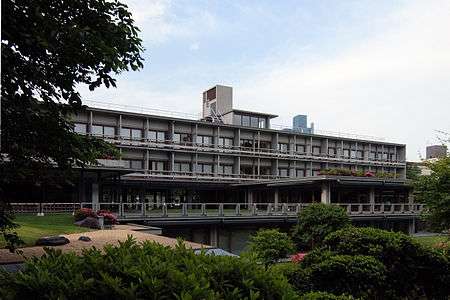Kunio Maekawa
| Kunio Maekawa | |
|---|---|
 Maekawa House in the Edo-Tokyo Open Air Architectural Museum | |
| Born |
14 May 1905 Niigata, Niigata |
| Died | 26 June 1986 |
| Nationality | Japan |
| Occupation | Architect |
| Practice | Mayekawa Kumio Associates |
| Buildings | The National Museum of Modern Art, Tokyo |
Kunio Maekawa (前川 國男 Maekawa Kunio, 14 May 1905 – 26 June 1986) was a Japanese architect especially known for the Tokyo Bunka Kaikan building, and a key figure of modern Japanese architecture.
Formative years
Kunio Mayekawa was born in 1905 in Niigata Prefecture in Japan. He entered First Tokyo Middle School in 1918, and then Tokyo Imperial University in 1925.[1] After graduation in 1928, he travelled to France to apprentice with Le Corbusier. In 1930 he returned to Japan and worked with Antonin Raymond (a student of Frank Lloyd Wright), and in 1935 established his own office Mayekawa Kunio Associates. His own house has been described as his starting point, in which he brought the idea of piloti inside the house, to create a two-storey space. The original house has been dismantled and relocated to the Edo-Tokyo Open Air Architectural Museum.[2]
In 1955 he designed and build his first project: the Kanagawa Concert Hall and Library. His perhaps most famous work, the Tokyo Bunka Kaikan, located in Tokyo's Ueno Park was completed in 1961. The building contains a main, large concert hall, a recital hall, as well as a rehearsal room and a music library.
Selected projects
- 1932 Kimura Industrial Laboratory, Hirosaki, Aomori
- 1936 Hinamoto Hall
- 1938 Dairen Town Hall
- 1942 Maekawa House
- 1952 Nippon Sogo Bank, Tokyo
- 1954 Kanagawa Prefectural Library and Music Hall, Yokohama, Kanagawa
- 1955 The International House of Japan, Tokyo (with Junzo Sakakura and Junzo Yoshimura)
- 1956 Fukushima Education Center, Fukushima
- 1959 Harumi flats, Tokyo
- 1959 Setagaya Community Centre, Tokyo
- 1960 Kyoto Kaikan, Kyoto
- 1961 Tokyo Bunka Kaikan, Ueno, Tokyo
- 1964 Hayashibara Museum of Art, Okayama
- 1966 Saitama Cultural Centre
- 1970 Steel Pavilion, Expo '70, Osaka
- 1974 Tôkyô Marine and Fire Insurance, Tôkyô
- 1975 Tôkyô Metropolitan Art Museum, Tôkyô
- 1976 Kumamoto Prefect. Museum of Art, Kumamoto
- 1977 Museum of East Asian Art, Cologne
- 1978 Yamanashi Prefecture Museum of Art, Kôfu
- 1979 Fukuoka Art Museum, Fukuoka
- 1979 National Museum Western Art Annex, Tôkyô
- 1982 Kumamoto Prefectural Theater, Kumamoto
 Kanagawa Prefectural Library and Music Hall, Yokohama (1954)
Kanagawa Prefectural Library and Music Hall, Yokohama (1954) The International House of Japan, Tokyo (1955)
The International House of Japan, Tokyo (1955) Fukushima Education Center, Fukushima (1956)
Fukushima Education Center, Fukushima (1956) Setagaya Ward Office
Setagaya Ward Office Tokio Marine & Nichido Fire Insurance Head Office (1974)
Tokio Marine & Nichido Fire Insurance Head Office (1974)
Honors and Awards
- 1953,'55,'56,'61,'62,'66 Prize of Architectural Institute of Japan
- 1959 Decorated with Riddare av Kungl. Vasaorden (Sweden)
- 1962 Asahi Prize
- 1963 UIA Auguste Perret Award
- 1967 Decorated with Suomen Leijonen Ritarikunnan l Luokan Komentajamerk (Finland)
- 1968 Grand Prize of Architectural Institute of Japan
- 1972 Mainichi Art Prize
- 1974 Prize of Japan Art Academy
- 1978 Decorated with Officier de l' ordre National du Merite (France)
References
Notes
- ↑ Reynolds 2001, pp. 38–44
- ↑ Fujimori 2008
Sources
- Reynolds, Jonathan M. (2001), Maekawa Kunio and the Emergence of Japanese Modernist Architecture, University of California Press, ISBN 0-520-21495-1
- Fujimori, Terunobu (2008), "Modernism and the Roots of Contemporary Architecture", Kateigaho International Edition, 20 (3), retrieved 2010-03-29
External links
| Wikimedia Commons has media related to Kunio Maekawa. |
- Mayekawa Associates
- Daniell, Thomas On Kunio Maekawa
- 100 Years Anniversary Exhibition
- Japan Photo | Maekawa Kunio